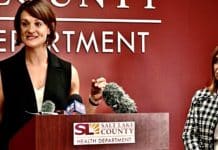SALT LAKE CITY, Utah, Jan. 8, 2022 (Gephardt Daily) — Utah’s top legislative leaders say they will review the new public health mask mandates issued in Salt Lake and Summit counties.
Friday, Salt Lake County Health Department announced Executive Director Dr. Angela Dunn had issued a public health order “requiring people in Salt Lake County, regardless of vaccination status or past COVID-19 infection, to wear well-fitting masks when indoors (or queueing outdoors) in public.”
Summit County Health Department issued a similar health order Jan. 6.
In a statement issued late Friday afternoon, Utah Senate President Stuart Adams and Utah House Speaker Brad Wilson released the following statement:
“The Legislature has outlined a process in S.B. 195 with multiple checks and balances. While we believe government mandates should be a last resort, we will review the recently issued orders.
“As other areas have experienced, we hope Utah’s current COVID-19 surge is temporary. We continue to encourage Utahns to get vaccinated and take precautions to keep themselves and those around them healthy without overwhelming our hospitals.”
Bipartisan Senate Bill 195, known as the Pandemic Emergency Powers Act, was passed in the 2021 General Session of the state Legislature.
The bill “limits (Utah) Department of Health and local health department powers related to public health emergency declarations and orders of constraint.” It also “limits emergency powers of the governor and chief executives of local governments” by “allowing the Legislature and local legislative bodies to terminate an executive order.”
The Salt Lake County mask order was scheduled to begin Saturday, Jan. 8, at 12:01 a.m. and is currently planned to be in effect until 5 p.m. on Monday, Feb. 7, 2022.
Salt Lake County Mayor Jenny Wilson expressed her approval for the plan in a statement Friday afternoon.
“I deeply appreciate the expertise of Dr. Angela Dunn, our County Public Health Director. I accept her recommendation for a 30-day countywide mask requirement in Salt Lake County,” Mayor Wilson said.
“The Omicron variant has spread rapidly. Just two weeks ago, we were at 500 cases a day in Salt Lake County. Today we sit at over 4,600 per day. We recognize the sense of urgency in our community as hospitals are threatened,” Wilson said. “We need to utilize every tool available to slow the spread and high-quality masks worn indoors in public spaces are a proven measure. Our county is open, we are running business as usual. This is a temporary step that is necessary to get us through this next phase of COVID,” Wilson said.
Salt Lake City Mayor Erin Mendenhall also called for the implementation of a countywide mask order Friday, first in a letter to Dunn and another to the Salt Lake County Council.
“It is our shared responsibility as leaders to protect every life we can,” Mendenhall said in a letter to Dr. Dunn. “So I write to you today to urge you to enact a life-saving county-wide mask requirement in public spaces during the next several weeks.”
In a similar letter to the Salt Lake County Council, Mendenhall also asked members to approve Dunn’s plan.
“As you know and as we have discussed in the past, a countywide requirement will do significantly more to protect our constituents than a mask requirement in Salt Lake City alone, both in reducing community transmission during the highly contagious Omicron wave, and in protecting the heroic medical staff at our overwhelmed hospitals,” Mendenhall said. “If we do not take this step for them now, there may not be enough healthy doctors and nurses on duty to take care of our constituents when this wave crests in a few weeks.”
The Salt Lake County Council can overturn the public health order or allow it remain in effect. In August, the Council voted along party lines to repeal Dunn’s order for a return to mask use in schools. If they allow the new order to stand, the state Legislature still has the ultimate authority to override the County Council’s decision.
The new mask order for Salt Lake County is as follows:
Under Utah Code Section 26A-1-114(1)(d), local health departments are vested with authority to establish measures as may be necessary to promote and protect public health and control the spread of disease. Consistent therewith, Utah Code Section 26A-1-106(2) provides that “[r]egulations or standards relating to public health or environmental health services adopted or established by a local health department may not be less restrictive than [Utah Department of Health orders].”
COVID-19 is a contagion that spreads from person to person. The Executive Director of the Salt Lake County Health Department recognizes the ongoing need for Salt Lake County and its residents to continue to work cooperatively and proactively to slow the spread of COVID-19 and to address the myriad challenges COVID-19 has created.
On November 26, 2021, the World Health Organization (“WHO”) declared the new COVID B.1.1.529 variant, named Omicron, a variant of concern due to mutations and preliminary evidence suggesting an increased risk of reinfection and spread across the world, including to the United States.
The WHO and the U.S. Centers for Disease Control and Prevention (“CDC”) have advised all individuals to take measures to reduce their risk of COVID-19, especially the Delta and Omicron variants, including proven public health and social measures such as wearing well-fitting masks, hand hygiene, physical distancing, improving ventilation of indoor spaces, avoiding crowded spaces, and being up to date on COVID-19 vaccinations.
The Omicron variant is far more contagious than the original virus and other variants, as evidenced by the record-breaking and unprecedented surge of COVID-19 cases over the past few weeks. Currently, Salt Lake County’s 7-day average percent positivity rate is nearly 30 percent, an increase of 65 percent from last week, and the 14-day case rate is 1856 cases per 100,000 people, an increase of 161 percent from the previous 14-day period. In addition, the 7-day total ICU utilization rate is at 89 percent, with COVID-19 ICU utilization at 26 percent.
THEREFORE, PURSUANT TO UTAH CODE SECTION 26A-1-114, BE IT HEREBY ORDERED BY DR. ANGELA C. DUNN, EXECUTIVE DIRECTOR OF THE SALT LAKE COUNTY HEALTH DEPARTMENT, AS FOLLOWS:
Section 1. Purpose. The intent of this Public Health Order of Constraint is to require every individual living within or visiting Salt Lake County, Utah, to wear a respirator (or until you are able to obtain a respirator, a well-fitting mask or face covering as an alternative) in public spaces while indoors or queueing outdoors. All provisions of this Order shall be interpreted to effectuate this intent.
Section 2. Definitions.
A. “Mask” or “Face Covering” is a physical barrier that:
1. Covers the nose and mouth completely, without transparent openings;
2. Is made of synthetic or natural fabrics;
3. Secures under the chin;
4. Fits snugly against the nose and sides of the face; and
5. Does not have an exhalation valve or vent.
B. “Respirators” are physical barriers designed and tested to meet international
standards and are labeled to identify the standard they meet. The most widely
available respirators that meet an international standard are KN95s. Other
examples of respirators include 1st, DL2, DL3, DS2, DS3, FFP2, FFP3, KN100,
KP95, KP100, P2, P3, PFF2, PFF3, R95, and Special. Respirators specifically
labeled “Surgical” N95 respirators should be prioritized for medical personnel.
Section 3. Respirators Mandatory. All individuals over the age of two years who can medically tolerate wearing a respirator (or until you are able to obtain a respirator, any well-fitting mask or face covering), regardless of COVID-19 vaccination status or past COVID-19 infection, must always wear a respirator, mask, or face covering in the following circumstances:
A. Inside of, or in line to enter, any indoor space, which is open to members of the public, including without limitation, grocery stores, restaurants, hotels, building lobbies, offices, retail stores, school classrooms, and other common shared spaces where individuals may interact, such as restrooms, hallways, elevators, and meeting rooms;
B. Obtaining services from the healthcare industry in settings, including without
limitation, a hospital, pharmacy, medical clinic, laboratory, physician or dental
office, veterinary clinic, or blood bank, unless otherwise directed by a healthcare provider;
C. Employees, staff, or volunteers engaging in work, whether inside at the workplace or performing work off-site, when:
1. Interacting in-person with any member of the public;
2. Working in any space visited by members of the public, regardless of whether anyone from the public is present at the time; and
3. Working in any space where food is prepared or packaged for sale or
distribution.
Section 4. Exemptions.
A. Notwithstanding any other provision of this Order, an individual required to wear a respirator, mask, or face covering, may remove it in the following situations:
1. While outdoors and not in queue with others;
2. While sleeping;
3. While actively eating or drinking, provided the individual remains in place while eating or drinking;
4. While alone or only with other members of the same household in a room, cubicle, vehicle, or similar enclosure;
5. When communicating with an individual who is deaf or hard of hearing if:
a. Communication cannot be achieved through other means; and
b. The speaker wears a face shield or uses alternative protection such as a
plexiglass barrier;
6. While obtaining or providing a service that requires the temporary removal of the respirator, mask, or face covering, such as speech therapy services;
7. While actively practicing or playing a competitive recreational or professional sport;
8. While giving an educational, artistic, cultural, musical, or theatrical presentation or performance for an audience;
9. While exercising or engaging in athletic training while indoors and maintaining at least six feet of physical distance from any other individual;
10. While swimming or on duty as a lifeguard; and
11. While purchasing a product or receiving a service that requires identification where the individual may briefly remove a respirator, mask, or face covering as necessary, so that the retailer or service provider can verify identity.
B. Notwithstanding any other provision of this Order, the following individuals are exempt from the respirator, mask, or face covering requirements:
1. An individual who is unconscious, incapacitated, or otherwise unable to remove
the respirator, mask, or face covering without assistance;
2. An individual with a medical condition, mental health condition, or intellectual or developmental disability, that prevents the individual from wearing a respirator, mask, or face covering; or
3. An individual who has an Individualized Education Program (IEP) under the
Individuals with Disabilities Education Act, 20 U.S.C. § 1414, or an accommodation under Section 504 of the Rehabilitation Act of 1973, 29 U.S.C. § 794, that would necessitate exempting the individual from wearing a respirator, mask, or face covering.
Section 5. Effective Date; Duration. This Public Health Order takes effect on January 8, 2022, at 12:01 a.m., and will continue to be in effect until 5 p.m. on Monday, February 7, 2022, unless extended, rescinded, superseded, or amended in writing, or otherwise as warranted.
The Summit County Health Department issued a similar order Jan. 6, 2022. To read that order, click here.
Gephardt Daily will update this story as more information is made available.






